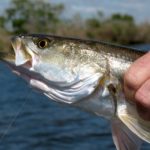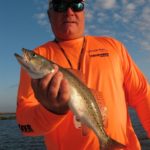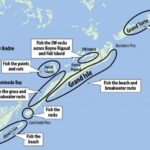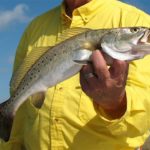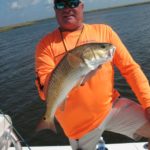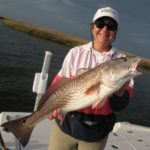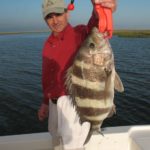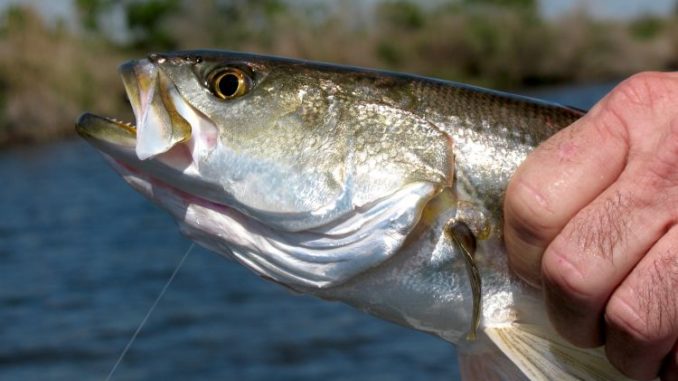
An easy guide to short-run trout on the beach, rocks
Whether you are a novice fishing Grand Isle, or a genuine old salt who’s been flinging baits around the island for decades, it’s a good idea to have a game plan for your day of plying the waters.
I asked an old friend, Capt. Keith “Herk” Bergeron, of Pair-A-Dice Charters (985-860-7855), to help me put together a game plan for fishing the island he calls home, but in particular I wanted his input on easy places to fish that wouldn’t require a long run by boat. Grand Isle is a perfect place for short run summer boat trips, situated as it is on the edge of the Gulf of Mexico. There are miles of beach, rocks and marsh worthy of anglers’ attention, but I wanted Herk to give me some specific places to target; places that are known for the consistent production of summer speckled trout. I wanted to know places where any angler could go — whether novice or seasoned expert — and find fish.
Herk said he’d oblige, and he offered to take me and a buddy out for a taste of the action.
I told the Assistant Pastor of our church, Joe Barreca, to meet me in the church parking lot in Kenner, at 3:45 a.m. Two hours later we pulled into the parking lot at Bridgeside Marina, and went looking for Capt. Herk.
Herk already had his boat in the water and live bait in the bait well, so he and his significant other, Nancy, were ready to roll out. Joe and I climbed aboard Herk’s brand-new 25-foot Pathfinder Bay Boat, the first, he said, in Louisiana waters. A 300-HP Yamaha provided the power and we headed out as light started breaking in the eastern sky.
On the ride, I explained to Herk that Joe and his family spent several years living in Russia and nearly a decade living in China as missionaries. But whether serving on foreign soil or locally, Joe had never actually caught a fish, and had never really been fishing at all, at least not from a boat.
Herk said not to worry, he’d make sure he was baptized in fish slime before the morning was over.
Grand Isle
Grand Isle itself is an 8-mile-long stretch of barrier island, and home to some 1,500 year-round residents. It is Louisiana’s only inhabited barrier island and home to the country’s oldest fishing rodeo, the International Grand Isle Tarpon Rodeo, that draws thousands of participants and spectators annually. Jean Landry, with the Grand Isle Tourist Commission, says the population swells to about 8,000 on weekends beginning with the Memorial Day weekend, and reaches its peak in July when it tops out at 10-15,000 for the Tarpon Rodeo. It is, without question, one of the premier fishing destinations in the state, and in the entire country.
Wherever I fish I always go armed to the teeth with my own tackle and gear, taking comfort with familiarity. I’d asked Herk the night before how we’d be fishing, pretty much knowing the answer before he replied.
On calmer days, we’d fish the beach along Elmer’s Island using live croakers for bait on a Carolina rig.
If we fished the rocks, we’d either freeline croakers or fish under a cork with live shrimp. I’d have to bring rigs ready for all occasions, and so will you.
The big Pathfinder hadn’t even come to a dead stop before eager Nancy loaded her hook with a live shrimp and started casting. And on her first cast she nailed a trout. That spurred me into action while Capt. Herk gave Joe some rudimentary instructions on using a spinning reel. After a few initial flubs, which is to be expected, Pastor Joe got the hang of it and was soon making casts and loading his own bait along with the rest of us.
Herk laid out a game plan easy enough to follow for boaters and anglers of all types, from the olive green novice to a crusty old salt.
The Rocks at Caminada Pass
These rocks begin as soon as you pass the pilings exiting Bridgeside Marina. The rocks line the shoreline around the western tip of the island and then extend out past the shoreline on the gulf side for a good distance before they submerge and extend out even farther, hiding just below the surface.
“These rocks hold fish, trout, reds, sheepshed, drum… really you could catch just about anything here being right on the pass and on the edge of the gulf,” Herk said. “The rocks here are no secret and you’ll see boats line up all along them, especially on weekends and holidays. You can catch fish all along them but the favorite spot seems to be towards the end on the gulf side of the pass. You can anchor off and fish towards them or you can try trolling if its calm enough and not crowded with boats. The key is to get your bait up close to the rocks without snagging them. Personally, I do not usually fish them because I avoid the crowd, but if I did, I’d toss a live croaker, freelined, right up against the rocks. You can’t use any weight at all or it’ll sink in the rocks and snag up. If you freeline it still might snag but if you give it slack the croaker will often pull itself free. The other option is to fish live shrimp under a cork near the rocks, but off far enough not to snag,” Herk said.
Author’s tip: You can also try tossing a topwater bait up close to the rocks when conditions allow, or even shallow diving crank baits.
The Breakwater Rocks on the Bay Side
The breakwater rocks were built in segments over a period of some 17 years, stretching from near the Caminada bridge for miles to the new Wildlife and Fisheries office. Designed as breakwaters to protect the fragile island from winter storms and north winds, they quickly became a marine habitat where bait congregates and predators follow. Herk says these rocks provide some of the islands easiest fishing.
“It’s safe water, easy to get to, and fish congregate along them. They’re easy to fish because all you need is some live shrimp and a popping cork rig. Anchor off near one of the corners and give it a few minutes to produce. You can also toss live croakers freelined up close to the rocks. Bottom rigs don’t work because the bottom is littered with rocks that’ll snag you up every time,” he said.
Herk says to be prepared to move a lot, from one breakwater to another.
“The trout haven’t been all stacked up in one spot. We’ll catch four or five fish, and then the action stops. Don’t just sit there, move. The rule of thumb is, the more you move, the more you catch. As long as you’re catching fish, stay put. But when the bite stops, move on. Move down 50 feet or so and try another spot. You can also try trolling, and when you get bites, stick there,” he said.
Always look for current moving around either end of the breakwater segments. You can fish all sides.
North/bay side
Herk says the grassy stretches along the north side of the island consistently produce redfish throughout the summer, and this year is no exception.
“There’s grass stretching all the way to the Wildlife and Fisheries building, miles of it,” he said. “We’ve been catching plenty reds in all the cuts and around the marshy islands. It’s shallow so troll and work a gold spoon, a beetle-spin or a topwater bait, or anchor at a good point or cut and fish a live minnow rigged shallow under a cork.”
Herk says the topwater action has been exceptional in the grass in the early mornings, late evenings, and on overcast days.
Dutch Island
Dutch Island is a big grassy island just to the north of Grand Isle in Caminada Bay. Herk says it is shallow, riddled with cuts and points and grassy marsh islands that hold fish, both reds and specks. He says to fish live shrimp under a popping cork at points and cuts and coves, and don’t hesitate to toss a topwater bait early or late for some explosive action.
Look for current moving around points and corners, and look for bait popping on the surface.
The rocks on the west and south side of Fifi Island
“There’s a lot of reds caught along those rocks,” Herk said. “But it is very shallow so don’t go running in there like gangbusters. Go slow, near idle speed and trim your motor up. Fish with live minnows or shrimp on a shallow leader under a cork, or toss a gold spoon or beetle spin, or a topwater bait.
Elmer’s Island
Elmers is, in my estimation, the premier fishing attraction for summer action. Mostly because I’ve slaughtered huge trout there in the past, but also because I love to fish the beach from a boat when the winds and seas allow it.
Herk says to follow the wisdom of what works. “Live croakers on a No. 3 kahle hook, on a Carolina rig with a 1/2-ounce sinker. Anchor in 3-4 feet of water, and fish in the first trough off the island in the early mornings.”
“I believe the trout look for protection from the predators at night. The best place to hide from hungry dolphin and shark is in the skinny water near the beach. In my experience that’s where we find them in the early mornings, in between the beach and the first sandbar. Later in the morning you can fish farther off the beach, but at first light fish inside the first sandbar,” he said.
Finding fish along the long sandy stretch of Elmers can be a challenge in itself, but there are several things to look for that can give away their position.
Four tips for fishing the beach
First, look for birds. Wherever you see seagulls diving at the surface along the beach, fish beneath them. Herk says to fish the birds even if they’re just sitting on the surface. He says if they’re sitting at a spot, it’s for a reason.
Second, look for irregularities such as wave breaks, nervous water, anywhere the wave pattern is a little different. Any of that can signify slightly deeper water, and baitfish hide in those bottom abnormalities. Naturally the trout will be in there after them, so that’s where you want to park your bait.
Third, use your depth finder. Idle slowly and look for those deeper troughs running out from the bank. Just a one foot difference in depth can make a big difference in fish production.
Fourth, look for bait. Wherever you find it, fish there.
South side of the island
Herk says to fish the breakwater rocks exactly the same way as those on the bay side. Freeline croakers right against the rocks, or back off a bit and fish live shrimp under a cork. Look for tide moving around corners, and look for bait.
The beach at Grand Terre
Just to the northeast of Grand Isle, on the other side of Barataria Pass, is Grand Terre. It has a good stretch of sandy beach, but Herk prefers to fish the section just before Coup Abel. He says you fish it exactly the same way you’d fish Elmer’s Island, up between the first sandbar and the beach early, and farther back in deeper water as the day progresses. Live croakers Carolina rigged are the go-to bait, on a No. 3 kahle hook.
Sometimes the fish are finicky, and won’t hit the croakers. Use a live shrimp on your Carolina rig instead and they’ll eat it up.
Meanwhile, we hid from blustery winds and building seas on the backside of the island and still managed a very respectable catch that included some nice trout, a few reds and some big sheepshead. Pastor Joe caught almost all the sheepshead, which we attributed to the fact that he brought bananas aboard the boat. A rookie mistake, we said, as we ate the bananas and kept throwing trout into the ice chest.
Capt. Keith “Herk” Bergeron can be reached at 985-860-7855.
Destination Information
Grand Isle is located at the end of LA. 1, about a two- to two-and-a-half hour drive from downtown New Orleans. Take I-10 west to I-310 south, and exit on Hwy. 90 towards Houma. Follow 90 to Hwy. 308 and turn left towards Grand Isle. Follow it all the way to the four-lane highway in Larose, turn left and take it all the way through Golden Meadow to Leeville where you get on the new elevated road to Fourchon (Toll: $3). Turn left in Fourchon at the exit of the elevated roadway to Grand Isle.
Marinas. Bridgeside Marina (985-787-2419), Sand Dollar Marina (985-787-2500).
Maps/Charts. Standard Aerial Map #344
Accommodations
There are at least 15 motels and cabin rental business on the island, along with dozens of camps available for rent by the night, weekend, week or month. Check with the Grand Isle Tourist Commission (985-787-2997) or individual ads in the magazine.
